This photograph of a row of terrace houses has turned up in the Reepham Archive collection.
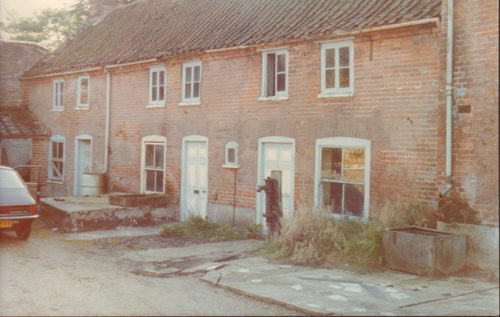
Does anyone have any idea or information about where this could be? It may be somewhere in the Reepham district.
Please send an email

This photograph of a row of terrace houses has turned up in the Reepham Archive collection.

Does anyone have any idea or information about where this could be? It may be somewhere in the Reepham district.
Please send an email
By Janet Archer
The December photograph in the Reepham Life Calendar 2021 shows the performers from the Sunday school in a nativity play held in St Mary’s in the 1950s, which includes Mrs McCubbin, the then vicar's wife, in the centre.
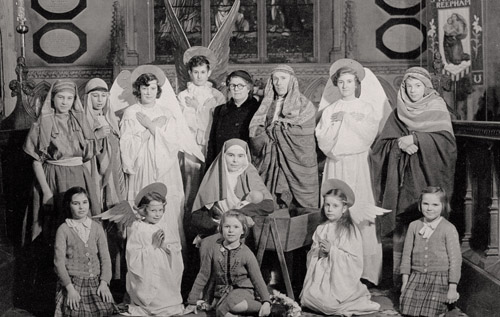
An additional photograph (below) shows a more formal, smaller group on the same occasion. Identification of some of the individuals can be found on the Reepham Archive website.
Sunday schools began to be established in the 18th century to provide basic lessons in literacy, as well as religious instruction for children who were often working alongside their parents on six days a week.
Robert Raikes, a Gloucester journal editor, is credited with establishing a successful Sunday school for poor and orphaned children in July 1780. As word of his work spread, Sunday schools soon appeared in other communities throughout England.
In Reepham in the 1920s every denomination ran a Sunday school: St Mary’s and St Michael’s, Wesleyan, Primitive and United Methodist, the Salvation Army and the Plymouth Brethren. Even parents who did not attend church thought that their children should attend Sunday school.
The Wesleyan Methodist Church had its own purpose-built schoolroom, which was added in 1904. Lessons were held prior to the Sunday morning church service where the children would join later with the adult congregation, followed by another session in the afternoon.
There would usually be a summer treat, possibly to the seaside, and a Christmas treat. Another important event was the Sunday School Anniversary where the children would give recitations and songs and be presented with prizes for good attendance.
In Wesley Piercy’s time in the 1920s the Sunday School Anniversary was in July. “A platform was erected in the chapel, on which sat all the Sunday school scholars and teachers and the choir. All the children had to give a recitation; no recitation, no treat. These were some of the biggest occasions of the year. All three chapels followed a similar pattern and were always packed on these occasions, when ladies could show off their new hats.”
The Reepham Archive is open to the public on the first Wednesday and Saturday of the month from 10 am – 12 noon (or by appointment), upstairs in the Bircham Centre, Market Place, Reepham. For more information about opening times and current services, please email
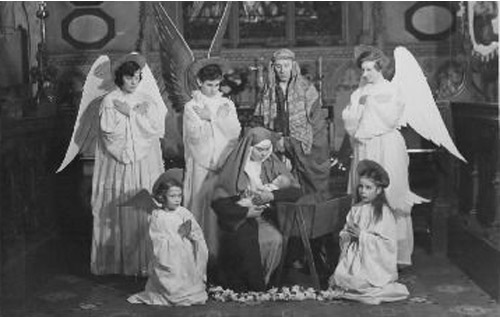
By Janet Archer
The photograph below shows a row of thatched cottages on Orchard Lane, Reepham, which, according to research, was demolished in the 1930s. (The end of the row can just be seen in the Reepham Life Calendar 2021 photograph for November.)
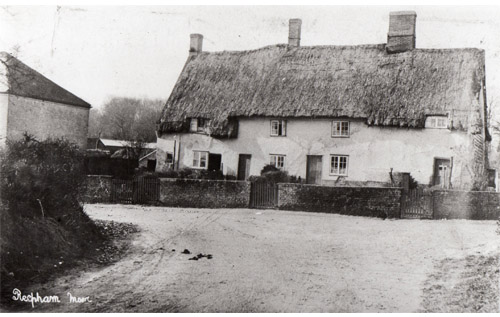
Photos: Reepham Archive
Today there is only one example left on The Moor of a thatched cottage.
Harry Hawes tells us that many thatched roofs were replaced with pantiles in the middle of the nineteenth century by his father Thomas Hawes.
A terrace that has remained intact is shown in the picture below.
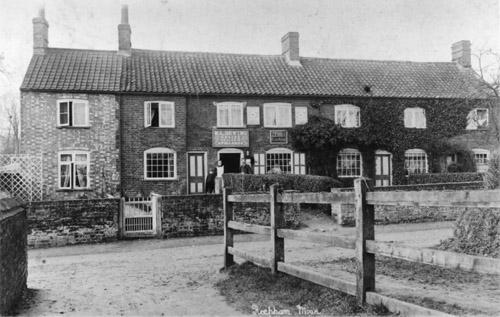
It included a shop run by Martin Luther Dewing, who began his working life as a grocer’s assistant in Aylsham, later setting up his own business in Dyball’s Yard.
This was behind the Old Brewery House in Reepham Market Place, where a few cottages and stables had been built after the sale of the Reepham Brewery in the late 1970s.
Martin Luther Dewing’s father, Thomas Dewing, ran a grocery and tailoring business in one of the cottages in the Old Monastery group.
Thomas had started his working life as a tailor’s apprentice, living with his family in Cawston.
The family were non-conformists and Thomas’s father Martin and his brother William were early trustees of Reepham Wesleyan Methodist Chapel.
Thomas’s census record in 1891 appears close to the Red Lion public house at the corner of Reepham Moor.
By 1901 his son Martin was trading in Reepham Moor, probably taking over his father’s premises after Thomas’s death in 1895.
(Bullards Brewery had apparently made a request in 1890 for the name of the public house to be changed to Red Lion and it seems that the property traded with that name for some time, reverting to the Black Lion by 1901.)
Information from Harry Hawes’ memories of Reepham in the 1870s, Wesley Piercy’s A Story of Reepham Methodist Chapel and Michael Black’ s research on Reepham Moor in the 1990s.
The Reepham Archive is open to the public on the first Wednesday and Saturday of the month from 10 am – 12 noon (or by appointment), upstairs in the Bircham Centre, Market Place, Reepham. For more information about opening times and current services, please email
The Reepham Archive has in its collection this photograph of an unknown man with a walking stick.
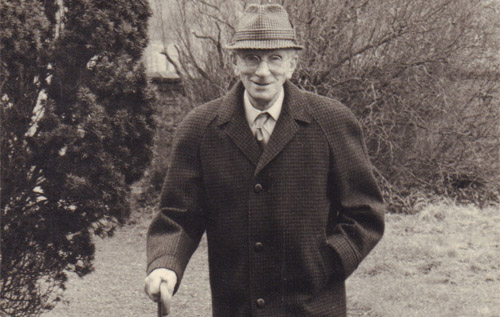
Does anyone have any information about who he is and when and where the photo was taken? Please send an email
By Janet Archer
Above the shop door in the Reepham Life 2021 Calendar photograph for October (probably from the mid-1920s) can be seen the name of E. Jewell, chemist and druggist and stockist of photographic materials.
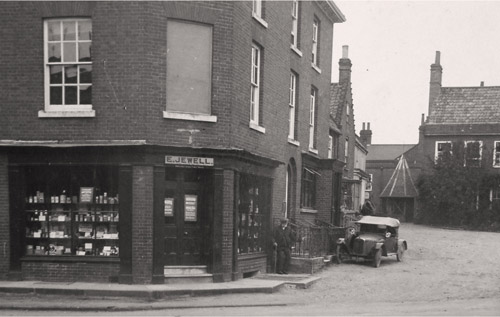
Edward Jewell had grown up in Reepham where his father George was a veterinary surgeon.
Edward joined the Royal Marines at the Portsmouth Depot in February 1871. Born in December 1853, he is listed as underage until December 1871 (18 must have been the qualifying age at that time).
By 1881 Edward had been promoted to colour sergeant and had served on several ships including the Hecla.
This ship was involved in the bombardment of Alexandria in 1882, an early action of the Anglo-Egyptian War, and Edward was awarded the Egypt Medal with the Alexandria Clasp and the Khedive’s Star.
After a career in the Royal Marines, which had ended in 1893, Edward finally became a farmer in Derbyshire, marrying a local girl, Sarah Redfearn, in 1904 at the Friends Meeting House in Manchester.
How long Edward had been a Quaker is not known, but this may have been where he met Sarah since he was resident in Manchester in the 1901 census.
Edward and Sarah first appear in the Hackford-next-Reepham electoral rolls in 1924.
Edward died in 1934 and Sarah and their daughter Elizabeth continued running the shop and in the 1939 register still seem to be in the same premises.
The photo below from the Reepham Archive is a postcard where Sarah has written on the back, “I am sending you a photo of our shop, & I was so angry I got snapped just as I was going in!”
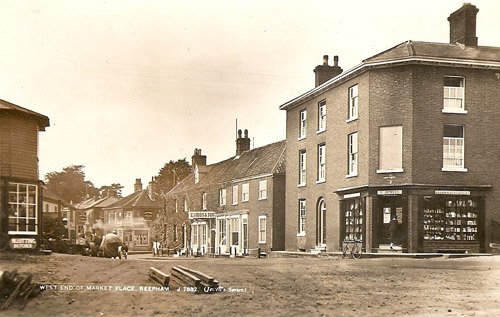
The business later moved across the Market Place to Ivy House, next to the Sun Inn.
Reepham residents may remember Elizabeth Grace Jewell still maintaining the shop after her mother’s death in 1959.
Ivy House had previously been the site of Reepham’s telephone exchange manned by Hester Wilton.
By 1939 Hester had retired and the exchange was being managed by her daughter Gladys. A newspaper report from December 1944, after Hester’s death, placed her as a “Woman in the News”.
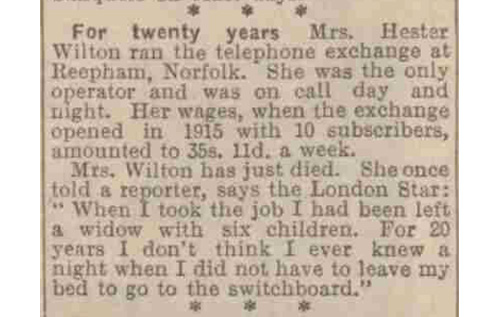
(Evening Express, April 24, 1944.)
When the Jewells moved out of the “Bank Building” the telephone exchange was moved across the Market Place to the house next to Gibbs’s premises and continued to be run by Hester’s daughter Gladys and her husband Robert Claxton. A small plaque exists today just by the front door saying, “The Old Telephone Exchange”.
Census information (inc. 1939 register) from ancestry.co.uk; newspaper report from findmypast.co.uk
The Reepham Archive is open to the public on the first Wednesday and Saturday of the month from 10 am – 12 noon (or by appointment), upstairs in the Bircham Centre, Market Place, Reepham. For more information about opening times and current services, please email
By Janet Archer
Bertie Alfred Woods was born in 1894 to Samuel Woods and Lydia Elizabeth Seaman. The family lived in Barn Cottage and there were at least 14 children, most of whom went to Salle School.
Bertie first attended school in 1899: “Admitted Bertie Woods this week. He is over five years old and can do nothing.”
In January 1900, Bertie and two of his sisters, Kate and Ethel, are reported as absent with whooping cough but they apparently had not been to school since the previous August. March 23rd brings the comment that Bertie and Ethel are away again.
At the end of 1891 Mary Jane Lomax had taken over the position of mistress at Salle School. Her first tasks recorded in the logbook were ruling two dozen slates and drawing up a new timetable.
She lived in the school house and stayed at Salle School until the end of 1903, so it is probably Mary Lomax who appears in this school photograph (below) from 1900, and she will have written the above comment about Bertie.
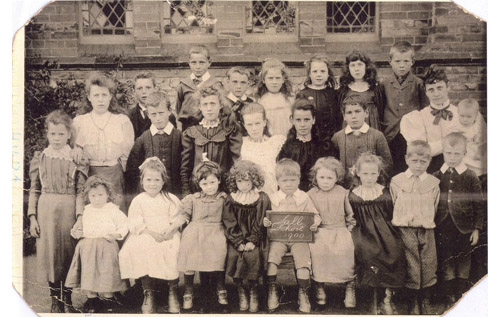
Most entries in the Salle and Reepham logbooks are mundane: daily records of attendance, closures due to sickness or seaside treats, and visits from school managers and inspectors. So, the following incident is unusual.
From 1903 the schoolmistress was Minnie Elizabeth Druitt, and she recorded the following in the logbook in 1906. (By this time Bertie is now about 12 years old and probably keen to leave school and some of his absences may have been to earn extra money for his family.)
“Am sorry to say that Bertie Woods who is the most indolent boy in the school is also very spiteful (going home) to young children and girls. Wrote a note to his parents but only received a rude answer.”
When he next came to school the mistress asked him to write an apology on his slate.

His mother came the following day and said he should sooner leave than write it. Accordingly, she took him out of school and the mistress marked him left.
Both Bertie and his brother Jesse left Salle School and instead went to Reepham School (St Mary’s on Norwich Road) where Richard Cornall was the master.
When the First World War began Bertie enlisted in the 5th Norfolks at Dereham. Later he served with the Worcestershire Regiment.
He is recorded as having died of wounds, age 23, in August 1917 and was buried in Mendinghem Military Cemetery, Belgium.
His name is remembered on the memorial inside Salle Church, and he has a memorial with his mother and father in Salle churchyard.
Information from National School Admission Registers & Log-Books, 1870-1914, @findmypast.co.uk; military Information from ancestry.co.uk
The Reepham Archive is open to the public on the first Wednesday and Saturday of the month from 10 am – 12 noon (or by appointment), upstairs in the Bircham Centre, Market Place, Reepham. For more information about opening times and current services, please email
The Reepham Archive has in its collection this intriguing photo of seven girls, a boy and a young female adult having a picnic on a lawn, probably in the 1950s, with some of the children possibly eating scones or cake.
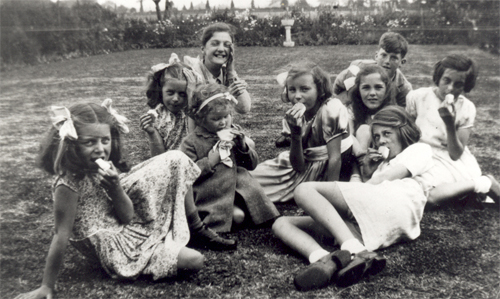
Does anyone have any information about who they are, where they might be and when the photo was taken? Please send an email
The Reepham Archive had a long-awaited visit today from Robin Sampson, community archivist at the Norfolk Record Office.
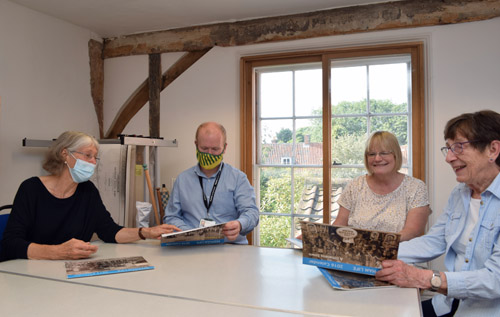
Photo: Charles Butcher
Earlier this year the Archive engaged in a series of online training sessions as part of a three-year project for town and village archives and local history groups from across the county, supported by a grant from the National Lottery Heritage Fund.
The Reepham Archive is one of around 30 groups in Norfolk receiving support from this project, which is providing local communities with the skills and assistance they need to create sustainable community archives.
As well as training, the project is providing materials for use by the archive groups, including the loan of digitisation equipment.
During the January–March period, Robin provided extensive training and advice and shared his expertise on the collection and storage of historical archives.
Volunteers at the Reepham Archive were delighted to welcome him in person at last after months of online meetings.
The Reepham Archive is open to the public on the first Wednesday and Saturday of the month from 10 am – 12 noon (or by appointment), upstairs in the Bircham Centre, Market Place, Reepham. For more information about opening times and current services, please email
Weston Longville: In furtherance of the cause of vaccination now so loudly and universally called for by the threatened visitation of smallpox, on Monday night, April 14th there was a somewhat novel entertainment at the Rectory, viz. “A Vaccination Tea”.
Those who wished to be “done” had been invited to meet Mr Williams of Mattishall, the Government Medical Officer for that purpose.
Twenty-six candidates presented themselves, and with the help of Miss Thompson from Guys Hospital, London, the whole operation was successfully accomplished in about an hour and a half, after which they all had tea on the lawn.
Published in the Sparham Deanery & District Magazine, 1902. (From typed notes made in the 1980s by Tony Ivins.)
By Janet Archer
During the Second World War, when many male and female adults were serving in the armed forces, the Reepham Band was dependent on its younger players.
As the Reepham Junior Band the players performed more than 70 concerts to members of the forces in the space of three years.
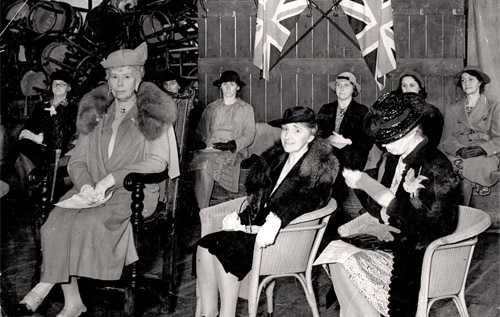
In recognition of this effort, Queen Mary (widow of George V and grandmother of the present Queen), made a special visit to Reepham with two of her ladies-in-waiting in the summer of 1945 (as pictured in the August photo, above, in the Reepham Life 2021 Calendar).
The Junior Band gave a concert in the Band Hall, conducted by Tommy Ruffles and were joined by the Primary Band (pictured below) conducted by Gordon Frankland.
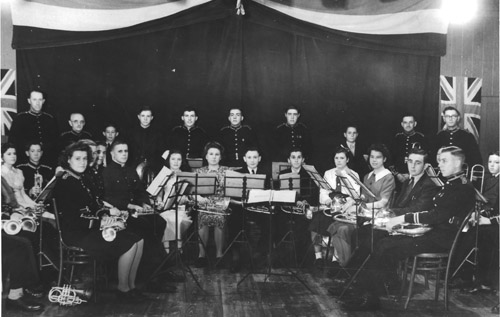
There were solos by Pam Barsted on cornet and Derek Woods on euphonium, and Queen Mary received a bouquet of carnations presented by the youngest band member, Pamela Reeder.
The Band Hall was originally erected as a new home for the Band of Hope, a temperance movement, which was launched in 1916, but by 1922 had expanded so much that it outgrew its original base in the United Methodist Chapel in Fisher’s Alley.
With funding and support from Jesse Bircham, the chemist on Norwich Road, and John Walker, who ran a household furnishing business, a large hall was built where the flats called The Maltings now stand.
When it was first built it was known as the Methodist Hall and mainly used for Band of Hope activities and meetings, which included a brass band, a string orchestra and a choir.
The movement began to decline in the 1930s and after the Methodist Union the hall was eventually put up for sale.
The Band of Hope brass band was still thriving and raised money to buy the hall, renamed it as the Band Hall and, under the leadership of Tommy Ruffles, became Reepham Town Temperance Band.
Following the concert Lady Cynthia Colville, one of the ladies-in-waiting, wrote that Queen Mary had been “greatly impressed by the performance, by the intelligence & enthusiasm of the young performers – including the very young! –, by the delightful surroundings (such a very pleasant hall & so beautifully decorated with flags & those lovely dahlias!)......”. One wonders if they noticed the chairs at the back!
Information from the Reepham Archive, My Town by Wesley Piercy and The Reepham Town Band by Joyce Cox.
The Reepham Archive is open to the public on the first Wednesday and Saturday of the month from 10 am – 12 noon (or by appointment), upstairs in the Bircham Centre, Market Place, Reepham. For more information about opening times and current services, please email